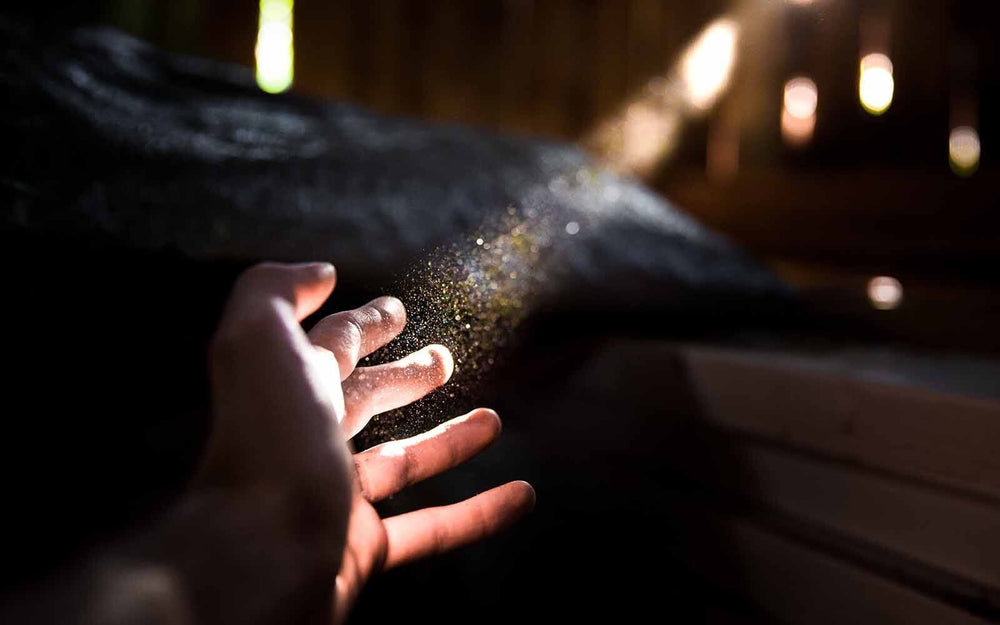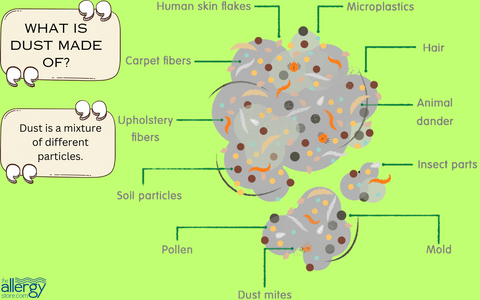
We’ve all been there. You dust all the furniture and a few days later it’s covered in dust again. You glance toward a window on a sunny day and see particles floating freely in the air.
So, what is dust, and where does all the dust in your house come from?
Believe it or not, it comes from you, your stuff, the other inhabitants of your house (invited and uninvited), and the outside. The dust in your house has many sources, but most of them start with you. Let’s look in detail.

You are a Major Source of Dust
While it may seem disgusting, some of that dust is little bits and pieces of you. Snakes shed their skin several times a year. Humans shed their skin all day, every day. You replace all of your skin every 4 to 5 weeks. That’s a lot of dead skin flakes.
Not only do those dead skin flakes collect in your mattress and pillow, but they also collect on the furniture and carpets. When you disturb these items, the skin flakes become airborne and settle again.
Not only do you shed skin, but you also shed hair, some more than others. Those hairs break down into smaller and smaller particles. Eventually, they are a component of your household dust.
The same applies to your eyebrows and eyelashes. If you use personal care products on your skin and hair, they can flake off independently of your skin or hair. Dust can contain bits of hair gel, spray, or mousse when your nail polish chips, that chip becomes dust.
The cartoon character Pigpen from the Peanuts comic strip wasn’t too far off. “Just like the ‘Peanuts’ comic strip character Pig-Pen, people walk around in a dust cloud all day,” says Heather M. Stapleton, an environmental chemist at Duke University.
Remember Pig-Pen; he traveled in a cloud of dust. We pretty much create our own dust as we move about our house.
Your Stuff is a Source of Dust
Not only are you a source of dust, but all of your stuff makes dust too. So, your clothing is made of fibers. These fibers shed and become dust.
If you use liquid fabric softener in the wash, you are making even more dust. Fabric softener coats the fibers of fabrics to make them feel soft and even smell good. But that coating isn’t permanent, and it flakes off the fabric. Then it becomes dust.
If your bedroom or bathroom is particularly dusty, it may be due to the liquid fabric softener you use. To remove the buildup, run ½ cup of white vinegar in the rinse cycle instead of fabric softener. It will remove any softener residue, soften the fabric and cut down on dust.
In addition to your clothes, your upholstered furniture, carpet, drapes, curtains, kitchen towels, and even your food are sources of dust. These bits of fibers and crumbs of food are a significant component of house dust.
Besides your hair, dead skin, clothing, and furniture, dust can hold a toxic mixture of persistent organic pollutants, metals, endocrine disruptors, human pathogens, and more. Researchers are finding an ever-growing list of chemicals in household dust.
Just like you, the other people in the house are busy creating their dust cloud. Their skin, hair, clothing, and belongings are all hard at work making dust. But it’s not just the people who create dust.
Dust mites love to eat that shed skin. These microscopic creatures live on a diet of human skin. They collect where it is warm and dark and slightly damp – that’s your bed. Dust mites feed on human skin and produce waste. Dust mite poop is another component of dust in your house, especially in the bedroom.
As they eat, they grow. As they grow, they shed the hard carapace that covers their body. This shed shell becomes house dust. And because nothing lasts forever, those dust mites die. Their dead bodies become dust.
So, house dust is full of dust mites, dust mite body parts, and dust mite feces. The only real way to ever combat this source of dust is to cover your mattress in a dust mite-proof mattress cover and wash your sheets once a week in 140°F water.
There are also lots of other uninvited guests in your house. Cockroaches feed on those crumbs of food in the dust. Then cockroaches poop. They die. House dust contains bits of cockroach body parts and feces.
The same applies to silverfish and other common household pests. This includes fleas and mites that live on mice. Oh, and the skin, fur, and droppings from mice can be part of the dust as well.
Your pets are a source of dust. Pet dander becomes part of the dust mix. Pets also leave dried bits of their saliva all over the house.
When they groom, the saliva sticks to their fur. It dries and flakes off. This saliva is the source of pet allergen, not the skin or fur, but the dried saliva. And it’s part of your house dust, too.
Cat saliva is particularly sticky. Cat allergen is found in the dust of places like airplanes, hospitals, and office buildings, where you wouldn’t expect cats to visit. That’s because it comes in on the clothing and hair of cat owners.
If you let a cat owner in your house, your house dust will probably have some cat allergen in it as well.
Pets also bring pollen and mold spores in from outside. These particles hitchhike a ride on your pet’s fur. Once inside it falls off and becomes part of your dust.
This leads us to the final source of house dust, the outside environment.
Dust Comes in From Outside
Dust also comes in through windows, doors, and cracks around windows and doors. Soil, mold spores, pollen, soot, and other outdoor debris find their way into your house dust. Like your pets, you carry some of this in on your hair and skin. You also carry it in on the packages you bring home from the store.
It is tempting to throw open the windows on a mild, sunny day, but you are only adding to the house dust. Trees near your home can create an excellent environment for birds. But those birds are a source of dust from their feathers and dust from bird mites. When you open your windows, you just let that dust inside.
Control Dust by Cleaning

It would be great if there were a magic device that could eliminate all the dust in your house. But there isn’t.
The best way to tackle dust is to minimize the things in your house that create dust and to clean regularly.
- Dust with a damp cloth or microfiber rags to remove dust. Always start at the top of a room and work down. Start with the ceiling fan.
- Vacuum frequently with a HEPA filtered vacuum.
- Damp-mop hard surface floors to remove dust.
- Run a HEPA air filtering machine that is the right size for the room.
Remember, the next time you wonder where the dust in your house comes from, take a quick look in the mirror. We make our dust and that can make dust allergy worse.
Wishing you the best of health
The Allergy Store
P.S. Allergy elimination is about eliminating the allergy-causing substance in your home the best you can. Once you do this, you may be able to eliminate the need for all the medications and doctor visits. For additional information please click here to download your free copy of" You Can Do It! Allergy Free Living.

